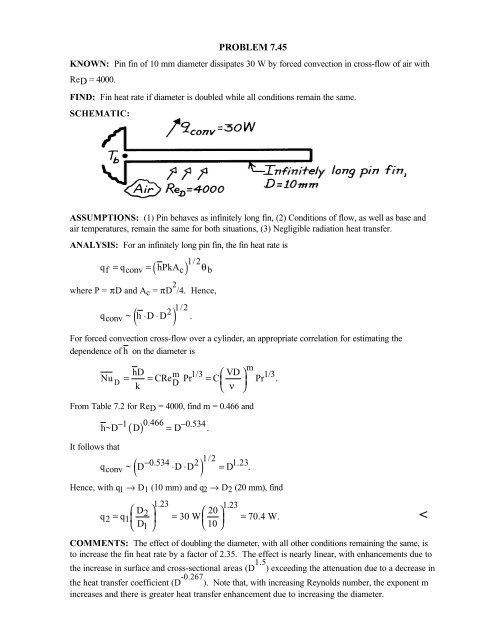HW Chapter 7
HW Chapter 7
HW Chapter 7
You also want an ePaper? Increase the reach of your titles
YUMPU automatically turns print PDFs into web optimized ePapers that Google loves.
PROBLEM 7.45<br />
KNOWN: Pin fin of 10 mm diameter dissipates 30 W by forced convection in cross-flow of air with<br />
ReD = 4000.<br />
FIND: Fin heat rate if diameter is doubled while all conditions remain the same.<br />
SCHEMATIC:<br />
ASSUMPTIONS: (1) Pin behaves as infinitely long fin, (2) Conditions of flow, as well as base and<br />
air temperatures, remain the same for both situations, (3) Negligible radiation heat transfer.<br />
ANALYSIS: For an infinitely long pin fin, the fin heat rate is<br />
( ) 1/2<br />
qf = qconv = hPkAc θ b<br />
where P = πD and A c = πD 2 /4. Hence,<br />
( ⋅ ⋅<br />
2) 1/2<br />
q conv ~ h D D .<br />
For forced convection cross-flow over a cylinder, an appropriate correlation for estimating the<br />
dependence of h on the diameter is<br />
m<br />
hD m 1/3 ⎛VD<br />
⎞<br />
Nu<br />
1/3<br />
D<br />
= = CRe<br />
D<br />
Pr = C Pr .<br />
k<br />
⎜<br />
ν ⎟<br />
⎝ ⎠<br />
From Table 7.2 for Re D = 4000, find m = 0.466 and<br />
It follows that<br />
h~D<br />
−1 D = D<br />
−0.534<br />
.<br />
( ) 0.466<br />
−<br />
( ) 1/2<br />
q<br />
0.534 2 1.23<br />
conv ~ D ⋅D⋅ D = D .<br />
Hence, with q 1 → D 1 (10 mm) and q 2 → D 2 (20 mm), find<br />
1.23 1.23<br />
⎛D2<br />
⎞ ⎛20<br />
⎞<br />
q2 = q1⎜ ⎟ = 30 W = 70.4 W.<br />
D<br />
⎜<br />
1<br />
10<br />
⎟<br />
⎝ ⎠ ⎝ ⎠<br />
COMMENTS: The effect of doubling the diameter, with all other conditions remaining the same, is<br />
to increase the fin heat rate by a factor of 2.35. The effect is nearly linear, with enhancements due to<br />
the increase in surface and cross-sectional areas (D 1.5 ) exceeding the attenuation due to a decrease in<br />
the heat transfer coefficient (D -0.267 ). Note that, with increasing Reynolds number, the exponent m<br />
increases and there is greater heat transfer enhancement due to increasing the diameter.<br />

















